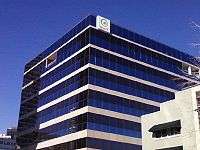Quark (company)
 | |
| Private company | |
| Industry | Computer software |
| Founded |
Denver, Colorado, U.S. (1981) |
| Founder |
Tim Gill Mark Pope |
| Headquarters | Denver, Colorado, United States |
Key people |
Raymond Schiavone (President and CEO) |
| Owner | Platinum Equity |
| Website |
www |

Quark Software Inc. (founded 1981 in Denver, Colorado) is a privately owned software company which specializes in enterprise publishing software for automating the production of customer communications. The company's original goal was to "create software that would be the platform for publishing", just as quarks are the basis for all matter.[1] The company is best known for its desktop page layout and design software, QuarkXPress, although this has now become secondary to its other products and services.
History
Quark was founded with $2000 in 1981 in Denver, Colorado, USA. Between 1981 and 1985 their primary products were Word Juggler and Catalyst. Word Juggler was the first word processor on the Apple III. Catalyst was a program that was distributed bundled with the Apple IIe, and allowed users to run floppy-disk based applications from their hard drive. They also attempted a product line called "Quark Peripherals", but the market for storage devices at the time resulted in a huge financial loss.
In 1986 Quark released QuarkXPress 1.0, which due to its precision quickly gained market share from Aldus Pagemaker. With the release of QuarkXPress 3.0 in 1990, Quark quickly achieved a dominant position in the desktop publishing market and became the standard for desktop publishing. By the end of the 1990s they gathered a market share of around 90%.
In the late 1990s, Quark faced intense criticism for slow innovation cycles, high prices, and a poor response to customer needs. Therefore, many customers welcomed the release of Adobe InDesign in 1999 as a viable alternative. The release of Adobe Creative Suite in 2003, essentially including InDesign with Photoshop and Illustrator, resulted in ongoing market share loss for QuarkXPress.
As a result, under the new leadership of Raymond Schiavone, Quark started to refocus its resources towards the enterprise dynamic publishing market, announcing a new strategy in March 2008.[2]
Ownership and management
Quark was founded under the name "Quark Engineering" 1981 by Tim Gill and Mark Pope.[3] In 1986 Fred Ebrahimi joined Quark as CEO and co-owner. In 1990, Mark Pope sold his share of the company to the other partners. In 2000 Tim Gill left Quark and sold all his shares to Ebrahimi.
In keeping with its India focus, Quark appointed Kamar Aulakh, a Quark veteran of Indian origin, as its CEO in February, 2004. In June 2005, Quark informed its employees that Aulakh was no longer with the company.[4]
At the end of 2006 Fred Ebrahimi gave all his shares of Quark Inc. to his children, with his daughter Sasha Ebrahimi taking the position of chairman.[5]
On November 1, 2006, Quark appointed Raymond Schiavone, former CEO of Arbortext, as its new CEO.
On August 9, 2011, the Ebrahimi family sold all their shares to Platinum Equity, a California-based private equity firm.[6][7]
Products
Quark's first products were word processing software for the Apple II and Apple III.[1] In 1987 it released its best known product, QuarkXPress, for Apple Macintosh. In 1992 it also released the product for Microsoft Windows. Along with Adobe's PostScript, Photoshop and Apple's computers, QuarkXPress could be considered one of the founding blocks of Desktop Publishing. QuarkXPress offered a degree of precision and set of features which were needed to make desktop publishing viable, and which rival PageMaker didn't offer at that time.
In the 1990s QuarkXPress 3.x gained around 90% market share of page layout applications. Its editorial workflow system, called Quark Publishing System, sold almost a thousand times to magazines and newspapers.
The company announced a picture editing application, QuarkXPosure, which was never released, and a multimedia authoring add-on XTension for QuarkXPress, QuarkImmedia. Neither is part of Quark's portfolio anymore. The company briefly purchased and marketed a standalone multimedia authoring program, mTropolis, before discontinuing it in the late 1990s.
Quark acquired two companies creating add-ons for QuarkXPress and InDesign, in 2005 alap[8] and in 2010 Gluon.[9]
In March 2008, Quark announced a new direction.[2] Quark acquired an XML editor vendor in 2008, a company called in.vision research.[10]
On May 29, 2012 Quark acquired Mobile IQ, with digital publishing technology for tablet devices named PressRun, later renamed to App Studio.[11]
Reflecting a shift towards Web-based word-processing tools such as Office 365 and Google Docs, in November 2014, Quark announced the release of a new authoring tool, Quark Author.[12]
References
- 1 2 "About Quark Software Inc. - Company History". Quark. Retrieved 2012-03-15.
- 1 2 "Quark Announces Dynamic Publishing Solution: Fills Much Needed Gaps in End-to-End Publishing Void". The Content Wrangler. Retrieved 2008-03-06.
- ↑ "social sciences - Gill, Tim". glbtq. 1953-10-18. Retrieved 2012-03-15.
- ↑ "Quark CEO abruptly leaves post - CNET News". News.cnet.com. Retrieved 2012-03-15.
- ↑ Avery, Greg (2009-03-08). "Software firm Quark rebounds, tries for innovator status again - Denver Business Journal". Denver.bizjournals.com. Retrieved 2012-03-15.
- ↑ Dove, Jackie. "Quark sold to merger and acquisition company". Macworld. Retrieved 2012-03-15.
- ↑ "Platinum Equity Acquires Quark". Quark.com. Retrieved 2012-03-15.
- ↑ "Quark Buys ALAP | News". The Mac Observer. Retrieved 2012-03-15.
- ↑ Spence, Nick. "Quark acquires Gluon assets". Macworld. Retrieved 2012-03-15.
- ↑ "Quark acquires In.vision for XML document handling". MacNN. 2008-07-17. Retrieved 2012-03-15.
- ↑ "Quark Acquires Mobile IQ for Enterprise Digital Publishing".
- ↑ "Quark Software Launches Quark Author – The Smart Content Tool". PRWeb. 2014-11-18. Retrieved 2014-11-18.